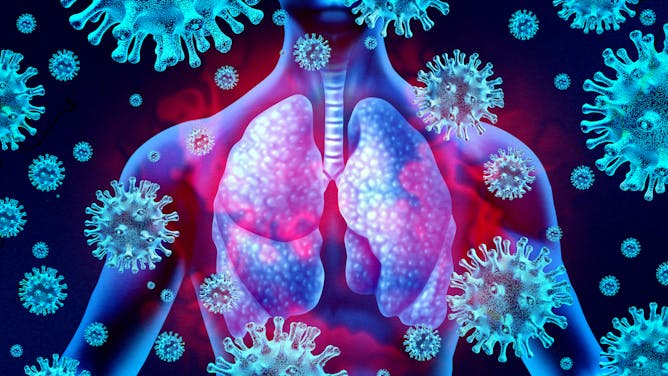|
Long COVID-19 has been described as the “pandemic after the pandemic,” with around 1 in 5 adults experiencing chronic symptoms after an infection – numbering to tens of millions suffering respiratory, cognitive and neurological impairments that can affect their daily life.
Researchers are still learning why the condition develops. Some, like immunologist Harish Narasimhan and his colleagues in the Sun Lab at the University of Virginia, point to the potential role of the immune system itself.
Narasimhan and his team conducted a review on what’s currently known about chronic symptoms that persist after viral respiratory infections like COVID-19, the flu and the common cold. They found that while a strong immune response may be indispensable to flushing out an invading virus, an overactive immune system that rages on in the lungs long after the fight is over can lead to more damage than good.
Also today:
|

|
Vivian Lam
Assistant Health and Biomedicine Editor
|
|

The immune system usually stays dormant in the lungs in times of health.
wildpixel/iStock via Getty Images
Harish Narasimhan, University of Virginia
While a strong immune response is essential to fight against viral infection, an immune system that continues to stay active long after the virus has been cleared can lead to lung damage.
|
Politics + Society
|
-
Joseph Nevins, Vassar College
A 1994 US policy was supposed to deter migration by securing popular access points. Instead, it drives people to enter the US by more hazardous means, such as being crammed in hot tractor-trailers.
-
Matthew A Baum, Harvard Kennedy School; Alauna Safarpour, Harvard Kennedy School; Kristin Lunz Trujillo, Harvard Kennedy School
Justice Samuel Alito said that abortion policy crafted by elected representatives in the states would be more responsive to what constituents want than federal protection of the right. He was wrong.
-
Jonathan H. X. Lee, San Francisco State University
While Chinese American voters are not a homogeneous group, many people who have ancestral ties to the region are unlikely to question their support for Nancy Pelosi just because of her Taiwan trip.
|
|
Science + Technology
|
-
Vivian Lam, The Conversation
From figuring out where memories are stored to how sensory information translates to behavior, new technologies are helping neuroscientists better understand how the brain works.
|
|
Economy + Business
|
-
Martha Olney, University of California, Berkeley
Rising inflation rates due to supply-side factors – COVID-19, Ukraine and supply chain shortages – make countering inflation difficult for the central bank.
-
Amitrajeet A. Batabyal, Rochester Institute of Technology
This global initiative advanced by the Chinese government lacks much-needed transparency and specific strategies.
|
|
Health + Medicine
|
-
Jonathan Foulds, Penn State
The proposed standard would lower the nicotine content in cigarettes and cigars by 95% – a public health proposal that could prevent millions from becoming smokers in the first place.
-
Zachary Gillen, Mississippi State University
Researchers are still trying to figure out exactly what happens within muscle to create knots, also known as myofascial trigger points. But they do know some ways you can avoid or alleviate them.
|
|
Environment + Energy
|
-
Nathan Jensen, The University of Texas at Austin College of Liberal Arts; Isabella Steinhauer, The University of Texas at Austin College of Liberal Arts
While Congress considers new renewable energy incentives, Texas’ sprawling wind farms tell a story about renewable energy ownership in the US – and who benefits from subsidies.
|
|
Ethics + Religion
|
-
Yuki Miyamoto, DePaul University
As Japanese victims struggled to process the nuclear attack, many turned to religion. The way they understood the horror still has consequences today.
|
|
Arts + Culture
|
-
Paula Vene Smith, Grinnell College
As material objects, diaries give scholars an intimate look into their subjects’ lives, including handwriting and mementos. What if diaries in the future are nothing but insubstantial digital ghosts?
|
|
|
|
|
|
| |
| |
| |
| |
|
|